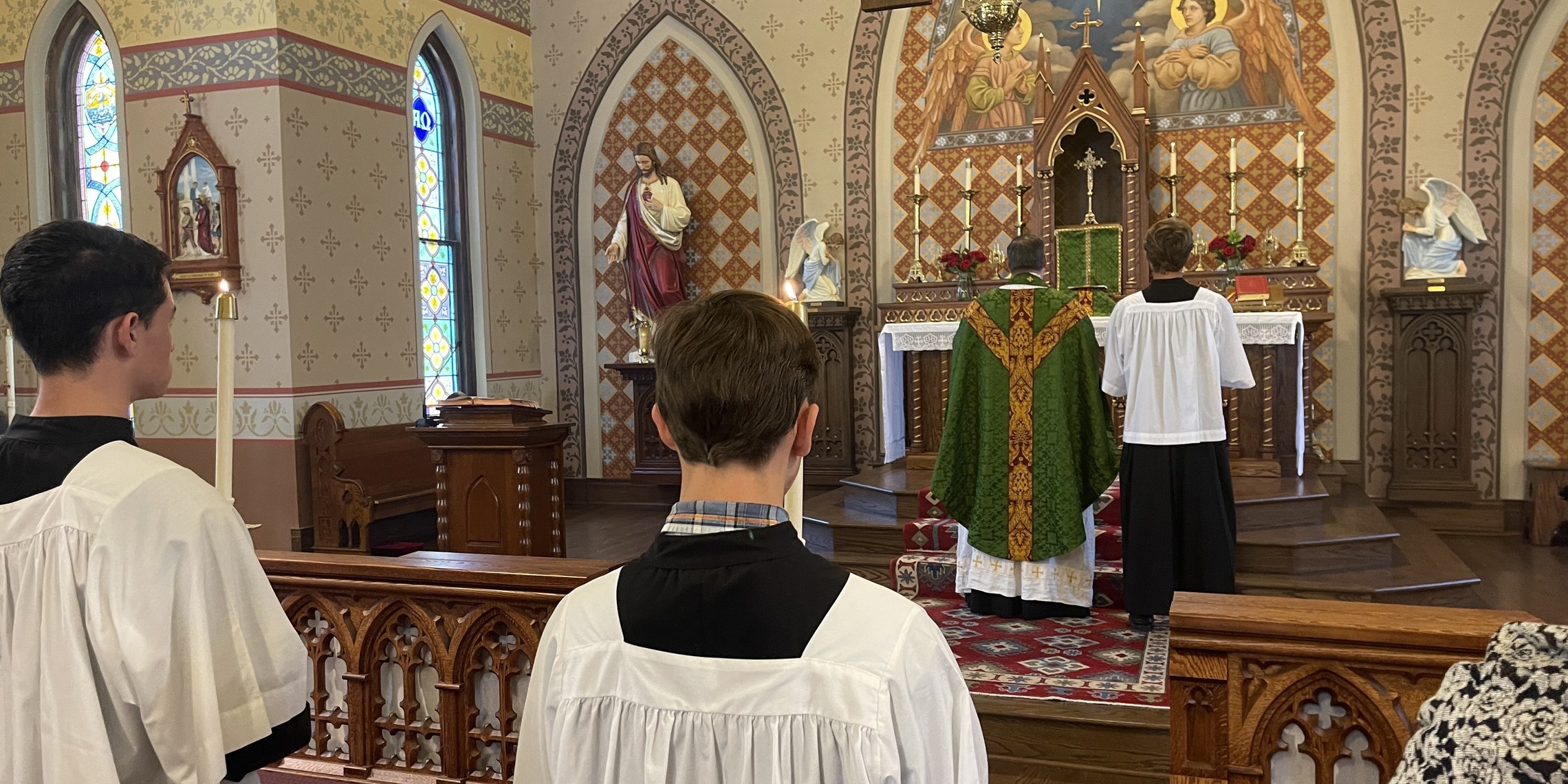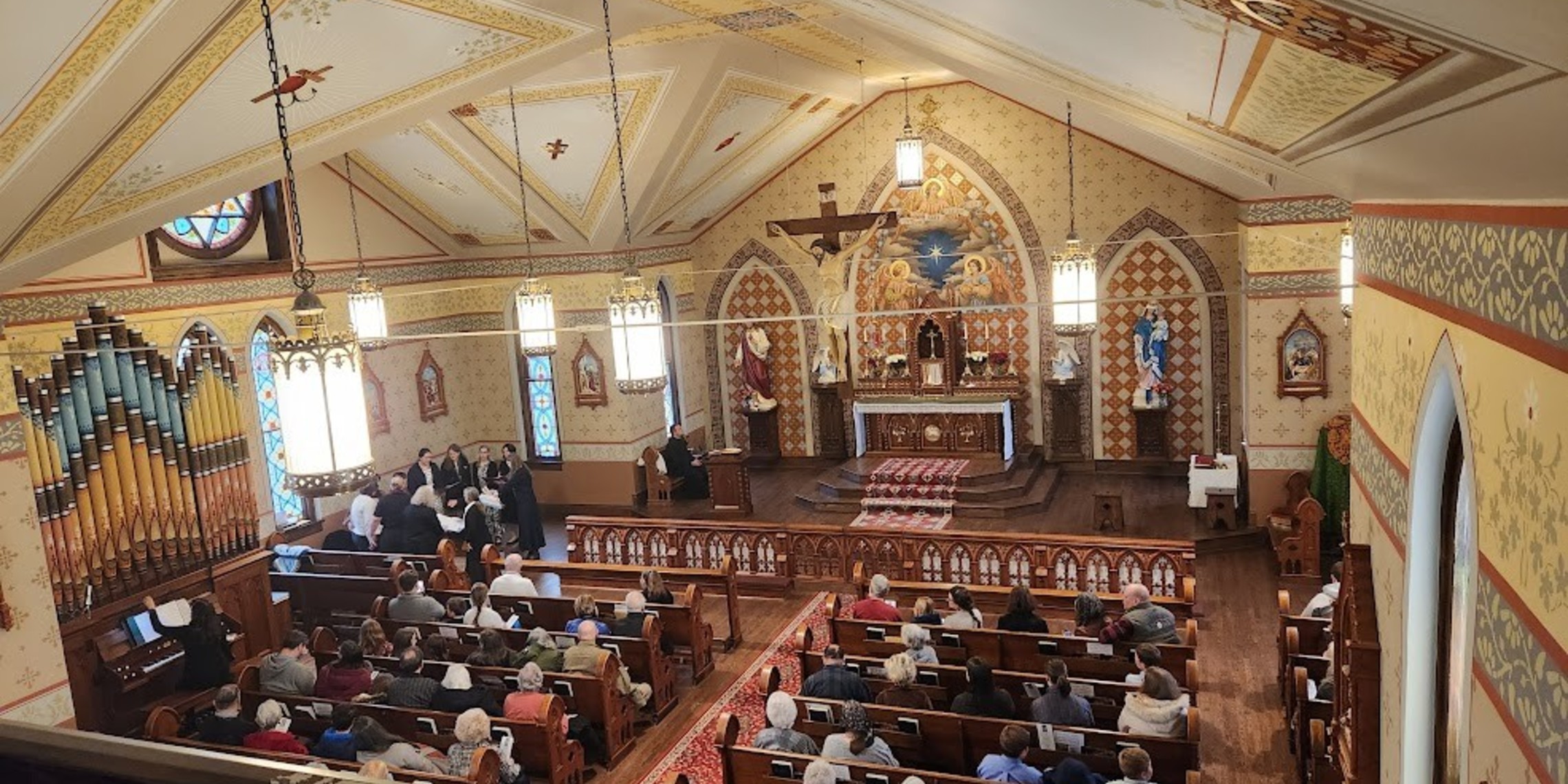Lately, at our 10:00am Mass at St. Ann, we have been diligently attempting the Roman Church’s “official” music. Some might say, “What do you mean? The Church actually has “official” music? You mean, it’s not just picking hymns like everyone else does? This is weird.”
St. Augustine once described the melismatic sound of the Alleluia as sonus quidam est laetitiae sine verbisthat is, “a certain sound of joy without words.” He was talking about the melodious chant of the Latin Church. And if we delve a bit more into this subject we will begin to find out that the Church’s traditional selection for music is anything but arbitrary, but is, in fact, ethereal and other-worldly and composed or handed down this way on purpose! What is the purpose of this style of singing? It is meant to evoke the sense that what is taking place (the praise of God through song) is, well, heavenly and not earthly. It is a type of song that is not congruous with “our time,” but is timeless.
While the topics about church music are endless and interesting for some, perhaps not for others, I wanted to start with the Gospel. In the Gospel of Matthew, we see Jesus singing a hymn before going out to the Mount of Olives for His agony in the Garden.[1] Exactly what were they singing?
In the mid-1950s, Jewish musicologist Eric Werner penned the book The Sacred Bridge which detailed his well-researched opinion on the music of the Jewish synagogue and Temple and its development in Christianity into Gregorian Chant (at least, in the West). I give you the online link to his book below.[2] Notwithstanding that some musicologists are in disagreement with Werner’s thesis, Werner’s point is that many of the Gregorian Chant melodies and the idea of “cantillation” or illuminating the sacred texts with song is one that is certainly held in common with our Jewish ancestors. One psalm in particular, Psalm 113 (114), used in Hebrew chant which details Israel’s exodus from Egypt almost has the exact melody when chanted at vespers in Latin. Other rich examples abound. Alleluia, Amen, for ever and ever, Hosanna, the thrice holy—are all of Jewish origin. Although we cannot go back in time to the early Church to hear the melodies being sung, there is a compelling argument for a relationship between the chanting of the old covenant and that of Christianity.
While obviously no recordings of music exist until the late 19th century, we do know that the passing on of sacred music was an oral tradition in both Judaism and Christianity even as late as the 11th century. As Christianity became the dominant religion of the Roman Empire, this Roman, Christian style of chant and song would’ve been the music which comprised the Ancient Mass parts. In synagogue Judaism, there were chants sung by the congregation as well as the more difficult melodious pieces sung by the hazan or cantor. Sometimes, both groups even traded stanzas back and forth (this is called antiphonal singing) both of which the Church adopted. St. Augustine himself describes this at the Mass of his time. Over time, as the music of the Church developed in the early Middle Ages, its singing became the duty of a particular group of clerics, typically men, and we get the term schola cantorum or school of singers. The term “Gregorian” chant was later ascribed to the music because tradition tells us that St. Gregory the Great in the sixth century helped to catalogue and reform the already extant music and Mass parts. (See Paul the Deacon’s biography of the saint). The entirety of all chanting for Mass would’ve been a lifetime of handing down these sacred melodies over and over again. During the 8th century, the Latin chant of Rome changed when Pope Stephen II crossed the alps to crown Pepin the Short King of the Franks around 752. It was here that the Mediterranean met the music of the Franks and the two styles were, over the reign of Charlemagne, blended into one—this gives us the “new” sound we have today.
The use of Gregorian Chant, the official music of the Roman Church, ebbed and flowed through the following centuries. With the advent of Protestantism in some northern nations and its influence coupled by the devastating effects of the French Revolution on Catholicism in the same country, the tradition of the Divine Office and the Church’s musical treasury declined and was corrupted.
It wasn’t until during the reign of Pope Bl. Pius IX in the late nineteenth century that the newly re-founded Solesmes Benedictine Congregation in France began the sacred duty of studying medieval manuscripts to rid the melodies of what they deemed as corrupted texts to authentically restore them. And during the reign of St. Pius X (1902-1918), the Church once again proposed her ever ancient and ever new sacred music making the Solesmes version the official edition of the Church. During the first half of the 20th century, the Church Herself sought with new vigor to restore her ancient song and did quite well at promoting it, especially in some American parishes, up until the advent of the Second Vatican Council (1962-1965).
Although the Second Vatican Council specifically taught that Gregorian chant was to have “pride of place”[3] at Mass for musical selection, its use quickly dried up with the promulgation of the 1969 Roman Missal and was almost lost again.
When we think about Church music, we can be tempted to choose what is comfortable, what is “normal-sounding” to us, but we should be reminded that when we enter into the sacred place of our church building, we are doing anything, but something “normative”—we are doing something extraordinary—we are encountering another world. We are reaching back to our Apostolic roots, and following them through the branches of our forbearers in faith for the last several thousand years all the way until our own time. We use a music that is timeless, a language that is considered “dead” by some but whose meaning doesn’t change with the times because God is timeless. The same or similar melodies were sung 500, 1000 or 1500 years ago by people with the same beliefs and same love for the worship of Almighty God at Holy Mass. And their roots go back to the same melodies that would have touched the ears of Christ Himself. What is that sound? Indeed, it is the sound of true spiritual joy which touches the intellect where Faith resides and lifts the mind and the heart to another place outside of our time. Even here at St. Ann in Plattsburg, Missouri, we have this delightful touchstone with the past which, by the grace of God, will shape our future. How grateful we are for the Church to form us!
[1] Matt. 26:30
[2] Werner, Eric. The Sacred Bridge. New York: Columbia University Press, 1959. https://archive.org/details/sacredbride007175mbp/page/n193/mode/2up
[3] Sacrosanctum concilium, 116. Constitution on the Sacred Liturgy. Second Vatican Ecumenical Council. December 4, 1963.
More News...
Final Sermon at St. Ann June 30th, 2024
.... In this last sermon I will give you before leaving for St. Andrew and my next journey, I would like to reflect upon...Read more
Rededication Mass Sermon
I would like to begin this evening with gratitude. Gratitude to all of you, the parishioners of St. Ann, for cooperating with the grace...Read more


